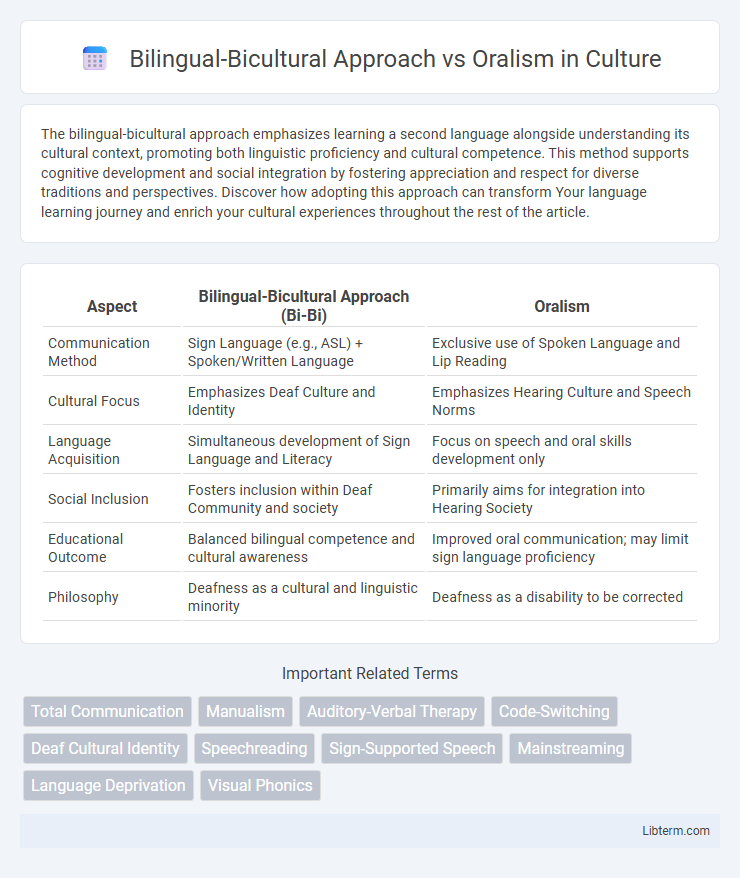The bilingual-bicultural approach emphasizes learning a second language alongside understanding its cultural context, promoting both linguistic proficiency and cultural competence. This method supports cognitive development and social integration by fostering appreciation and respect for diverse traditions and perspectives. Discover how adopting this approach can transform Your language learning journey and enrich your cultural experiences throughout the rest of the article.
Table of Comparison
| Aspect | Bilingual-Bicultural Approach (Bi-Bi) | Oralism |
|---|---|---|
| Communication Method | Sign Language (e.g., ASL) + Spoken/Written Language | Exclusive use of Spoken Language and Lip Reading |
| Cultural Focus | Emphasizes Deaf Culture and Identity | Emphasizes Hearing Culture and Speech Norms |
| Language Acquisition | Simultaneous development of Sign Language and Literacy | Focus on speech and oral skills development only |
| Social Inclusion | Fosters inclusion within Deaf Community and society | Primarily aims for integration into Hearing Society |
| Educational Outcome | Balanced bilingual competence and cultural awareness | Improved oral communication; may limit sign language proficiency |
| Philosophy | Deafness as a cultural and linguistic minority | Deafness as a disability to be corrected |
Introduction to Deaf Education Methods
The Bilingual-Bicultural approach in deaf education emphasizes the use of both sign language and written/spoken language, fostering cultural identity and cognitive development among Deaf students. In contrast, Oralism prioritizes speech and lip-reading skills, aiming to integrate Deaf individuals into the hearing world by minimizing sign language usage. Understanding these methods is crucial for effective teaching strategies that address linguistic and cultural needs within Deaf education.
Defining the Bilingual-Bicultural Approach
The Bilingual-Bicultural Approach emphasizes teaching Deaf students both American Sign Language (ASL) and English, fostering fluency in two languages and cultural identities simultaneously. This method supports cognitive development by recognizing Deaf culture and ASL as foundational, integrating English literacy through explicit instruction rather than oral speech alone. Unlike Oralism, which prioritizes spoken language and lip-reading, the Bilingual-Bicultural Approach values visual language acquisition and cultural inclusivity to enhance educational outcomes.
Understanding Oralism in Deaf Education
Oralism in deaf education emphasizes teaching speech and lip-reading to integrate deaf students into hearing society, often limiting sign language use. This method prioritizes auditory-verbal skills, sometimes at the expense of natural sign language acquisition and cultural identity. Understanding oralism highlights the contrast with Bilingual-Bicultural approaches that promote fluency in both sign language and written/spoken language, supporting comprehensive communication and cultural inclusion.
Historical Context and Evolution
The Bilingual-Bicultural (Bi-Bi) approach emerged in the late 20th century as a response to the limitations of Oralism, which dominated Deaf education from the late 19th century, emphasizing speech and lip-reading over sign language. Historical rejection of sign language in favor of oral methods led to a significant decline in Deaf cultural identity and language access, prompting advocates to promote Bi-Bi education that values American Sign Language (ASL) and Deaf culture alongside English literacy. Over time, the evolution from Oralism to Bi-Bi reflects a paradigm shift toward recognizing Deaf individuals' linguistic rights and the importance of visual language in cognitive and social development.
Language Acquisition: Sign Language vs Speech
The Bilingual-Bicultural (Bi-Bi) approach emphasizes early acquisition of sign language as a natural first language, fostering cognitive and social development in deaf children. Oralism prioritizes speech and lip-reading skills to promote spoken language, often delaying or limiting access to sign language. Research shows that early exposure to sign language enhances language acquisition and literacy outcomes compared to exclusive focus on oral methods.
Cognitive and Social Development Outcomes
The Bilingual-Bicultural approach promotes cognitive flexibility and enhanced executive functioning by exposing children to both sign language and spoken language, fostering improved problem-solving and metalinguistic skills. Oralism, which emphasizes speech and lip reading, often limits access to natural language acquisition, potentially hindering cognitive development and delaying social-emotional growth. Research indicates that early bilingual exposure in Deaf children supports stronger social identity formation and peer interaction compared to the oral-only method.
Cultural Identity and Community Impact
The Bilingual-Bicultural Approach fosters cultural identity by embracing both sign language and spoken/written language, enabling Deaf individuals to participate fully in both Deaf and hearing communities. Oralism centers on speech and lip-reading, often limiting access to Deaf cultural norms and diminishing community bonding among Deaf individuals. Emphasizing sign language within education strengthens Deaf cultural pride and social cohesion, whereas Oralism may lead to cultural isolation and loss of Deaf heritage.
Academic Performance Comparisons
Studies comparing the bilingual-bicultural (Bi-Bi) approach and oralism reveal that students educated through Bi-Bi methods often achieve higher academic performance, demonstrating stronger literacy and cognitive skills in both sign language and written language. Oralism, which emphasizes speech and lip-reading, may limit access to fully accessible language models, potentially hindering literacy development and overall academic achievement. Research indicates that early exposure to a natural sign language within Bi-Bi programming fosters enhanced language acquisition and academic outcomes compared to oral-only instructional methods.
Parental and Educator Perspectives
Parents and educators who support the bilingual-bicultural approach emphasize the cognitive and social benefits of mastering both sign language and spoken language, fostering Deaf identity and cultural inclusion. In contrast, proponents of oralism prioritize spoken language development and auditory skills to integrate deaf children into hearing society, often viewing sign language as a potential hindrance. Research shows that parental involvement and educator training significantly influence the success of either approach, with tailored support improving language acquisition and overall development outcomes.
Future Trends in Deaf Education
Future trends in deaf education emphasize the integration of the Bilingual-Bicultural (Bi-Bi) approach, promoting American Sign Language (ASL) fluency alongside English literacy to foster cognitive, social, and cultural development. Oralism, which prioritizes speech and lip reading without sign language, faces challenges due to insufficient language access and slower language acquisition outcomes. Advances in technology and research support the Bi-Bi model's effectiveness, driving increased adoption of inclusive curricula that honor both Deaf culture and linguistic diversity for optimal academic success.
Bilingual-Bicultural Approach Infographic

 libterm.com
libterm.com